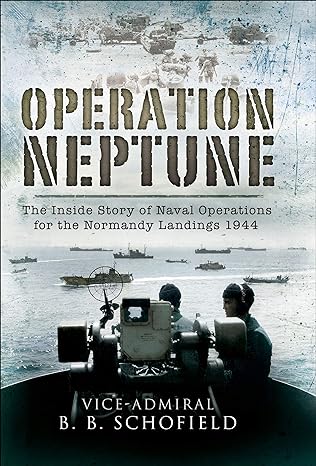
Operation Neptune. Naval Operations for the Normandy Landings 1944. By Vice Admiral B.B. Schofield CB CBE. Pen & Sword, Barnsley, 2024.
Reviewed by Peter Jones
To mark the 80th Anniversary of the Allied landings on the Normandy beaches, Pen and Sword has republished, in paperback form, Vice Admiral Brian Bethan Schofield’s masterly account of the naval component of the amphibious landings.
It was done with the assistance of Schofield’s historian daughter Victoria Schofield, who has also helped realise in print form her father’s fascinating memoir With The Royal Navy in War and Peace: O’er the Dark Blue Sea (2019) and, this year, the updated The Rescue Ships and the Convoys.
Many retired naval officers of a certain vintage will well remember the original hardcover, in small B5 format, published in 1974. It was part of an eventual sixteen volume ‘Sea Battles in Close Up’ series which covered predominately World War II actions involving the Royal Navy. What distinguished these books was that they were often written by naval officers turned historians who had some connection with the subject. Schofield wrote three of these very readable volumes that laid out the operations in the clear and concise English typically expressed on paper by naval officers of that generation.
The first edition was published in 1974, the year Frederick Winterbotham first broke the story of the Ultra code breaking story in The Ultra Secret. As such, Schofield did not mention Ultra’s role in the operation. This does not detract from Operation Neptune as there are many other books covering this aspect of the operation, notably Sir Max Hastings’ Overlord.
Schofield’s connection to Operation Neptune was twofold. In 1941-42 he was in the Admiralty’s Trade Division where some early work was done on the amount of shipping required for the eventual landings in France. More significantly, he was in 1944 Commanding Officer of the shore establishment HMS Dryad where General Eisenhower’s Battle Headquarters was situated. As an aside, those RAN officers like me who undertook the Principal Warfare Officers Course at Dryad will no doubt remember the large wall map of Normandy in the Wardroom ante room. The personal connection to Neptune gives an authenticity to Schofield’s account of this mammoth operation and the personalities involved. His assessment of General Eisenhower is illuminating and in part he says that “this outstanding but little-known soldier had initiated the concept of an integrated Allied command under a Supreme Commander and had shown that it could be made to work.” Schofield’s account of Operation Neptune well illustrates its scale, but also that commanders, such as Eisenhower and his naval deputy Admiral Bernard Ramsay, had to be comfortable in dealing not only with complexity, but also ambiguity. The book also demonstrates the importance of individual ships and individuals themselves in getting things right at critical times. My own operational experience leads me to think that Schofield is pointing out some enduring characteristics about large operations.
With the original edition scarce as hen’s teeth it is excellent to see that this fine book has been re-published for the benefit of contemporary naval officers and all those seeking to understand naval operations.



